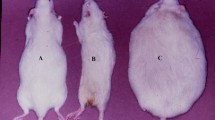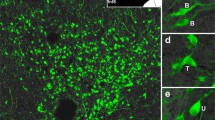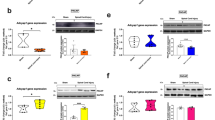Abstract
Scrapie is a transmissible neurodegenerative disease which shares some characteristics with Alzheimer disease (AD). Recent studies show abnormal enlargement of the adrenal glands and kidneys in 139H-affected hamsters. Using immunocytochemical techniques with antibodies to corticotropin-relasing factor (CRF) and vasopressin (VP), we observed the following: (1) a significantly higher number of CRF-immunostained neurons in the preoptic nucleus of hypothalamus of 139H-affected hamsters than controls; (2) the area of VP-immunostained (ir-VP) neurons in the lateral hypothalamus, which includes the internuclear group of magnocellular neurons and the nucleus circularis, was significantly lower for 139H-affected hamsters than for controls; and (3) no significant difference between 139H-affected and control hamsters with regard to the number of ir-VP neurons in the dorsalmedial hypothalamus (DMH), including the paraventricular hypothalamus, or the supraoptic nuclei. However, the population of ir-VP neurons in the DMH shifted to the anterior part of the hypothalamus in 139H-affected hamsters. Three-dimensional models of the immunostaining were prepared and these provide clear depictions of the changes noted. The changes in the CRF and VP systems in 139H-affected hamsters suggest that the neuroendocrine system can be affected by unconventional slow infections.
Similar content being viewed by others
References
Bendheim PE, Brown HR, Rudelli RD, Scala LJ, Goller NL, Wen GY, Kascsak RJ, Cashman NR, Bolton DC (1992) Nearly ubiquitous tissue distribution of the scrapie agent precursor protein. Neurology 42: 149–156
Braendgaard H, Evans SM, Howard CV, Gundersen HJG (1989) The total number of neurons in the human neocortex unbiasedly estimated using optical disectors. J Microsc 157: 285–304
Bucht G, Adolfsson R, Lithner F, Winblad B (1983) Canges in blood glucose and insulin secretion in patients with senile dementia of Alzheimer type. Acta Med Scand 213: 387–392
Carp RI, Callahan SM, Sersen EA, Moretz RC (1984) Preclinical changes in weight of scrapie-infected mice as a function of scrapie agent-mouse strain combination. Intervirology 21: 61–69
Carp RI, Kim YS, Callahan SM (1990) Pancreatic lesions and hypoglycemia-hyperinsulinemia in scrapie-injected hamsters. J Infect Dis 161: 462–466
Carp RI, Ye X, Kasasak RJ, Rubenstein R (1994) The nature of the scrapie agent: biological characteristics of scrapie in different scrapie strain-host combinations. Ann NY Acad Sci (in press)
De Souza EB (1988) CRH defects in Alzheimer's and other neurologic diseases. Hosp Pract 59–71
Dickinson AG (1976) Scrapie in sheep and goats. In: Kimberlin RH (ed) Slow virus diseases in animals and man. North-Holland, Amsterdam, pp 210–243
Eklund CM, Kennedy RC, Hadlow WJ (1967) Pathogensis of scrapie virus infection in the mouse. J Infect Dis 117: 15–22
Everall IP, Luthert PJ, Lantos PL (1991) Neuronal loss in the frontal cortex in HIV infection. Lancet 337: 1119–1121
Ferris CF, Axelson JF, Martin AM, Roberge LF (1989) Vasopressin immunoreactivity in the anterior hypothalamus is alterd during the establishment of dominant/subordinate relationships between hamsters. Neuroscience 29: 675–683
Fliers E, Swaab DF, Pool CW, Verwer WH (1985) The vasopressin and oxytocin neurons in the human supraptic and paraventricular nucleus; changes with aging and in senile dementia. Brain Res 342: 45–53
Goudsmit E, Fliers E, Swaab DF (1989) Changes in vasopressin neurons and fibers in aging and Alzheimer's disease: reversibility in the rat. In: Iqbal K, Wisniewski HM, Winblad B (eds) Alzheimer's disease and related disorders. Alan R. Liss, New York, pp 1193–1208
Goudsmit E, Neijmeijer-Leloux A, Swaab DF (1992) The human hypothalamo-neurohypophyseal system in relation to development, aging and Alzheimer's disease. Prog Brain Res 93: 237–248
Hatton GI (1990) Emerging concepts of structure-function dynamics in adult brain: the hypothalamo-neurohypophysial system. Prog Neurobiol 34: 437–504
Herman IP, Cullinan WE, Morano MI, Watson SJ (1992) Involvement of the ventral hippocampus in regulation of the hypothalamo-pituitary-adrenocoritical axis. Soc Neurosci Abstr 18: 1541
Kascsak RJ, Rubenstein R, Carp RI (1991) Evidence for biological and structural diversity among scrapie strains. Curr Top Microbiol Immunol 172: 139–152
Kim YS, Carp RI, Callahan SM, Natelli M, Wisniewski HM (1988) Adrenal involvement in scrapie-induced obsity. Proc Soc Exp Biol Med 189: 21–27
Kim YS, Carp RI, Callahan SM, Natelli M, Wisniewski HM (1990) Vacuolization, incubation period and survival time analysis in three mouse genotypes injected stereotactically in three brain regions with the 22L scrapie strain. J Neuropathol Exp Neurol 49: 106–113
Kimberlin RH (1989) Introduction to scrapie and perspectives on current scrapie research. In: Iqbal K, Wisniewski HM, Winblad B (eds) Alzheimer's disease and related disorders. Alan R. Liss, New York, pp 559–566
Lippa CF, Smith TW (1992) The indusium griseum in Alzheimer's disease: an immunocytochemical study. J Neurol Sci 111: 39–45
Martignoni E, Petraglia F, Costa A, Genazzani AR, Nappi G (1990) Dementia of the Alzheimer type and hypothalamus-pituitary-adrenocortical axis: changes in cerebrospinal fluid corticotropin releasing factor and plasma cortisol levels. Acta Neurol Scand 81: 452–456
Nagashima K, Zabriskie JB, Lyons MJ (1992) Virus-induced obesity in mice: association with a hypothalamic lesion. J Neuropathol Exp Neurol 51: 101–109
Oesch B, Westaway D, Wälchli M, McKinley MP, Kent SBH, Aebersold R, Barry RA, Tempst P, Teplow DB, Hood LE, Prusiner SB, Weissmann C (1985) A cellular gene encodes scrapie PrP 27–30 protein. Cell 40: 735–746
Palkovits M, Leranth C, Gorcs T, Scott Yung W III (1987) Corticotropin-releasing factor in the olivocerebellar trace of rats: demonstration by light- and electron-microscopic immunohistochemistry and in situ hybridization histochemistry. Proc Natl Acad Sci USA 84: 3911–3915
Parry HR (1983). In: Oppenheimer DR (ed) Scrapie disease in sheep. Historical, clinical, epidemiological, pathological and practical aspects of the natural disease. Academic Press, London, pp 2–7
Peter RE (1986) Vertebrate neurohormonal systems. In: Pang PKT, Schreibman MP (eds) Vertebrate endocrinology: fundamentals and biomedical implications, vol 1. Academic Press/Harcourt Brace Jovanovich, New York, pp 57–104
Scott JR, Fraser H (1984) Degenerative hippocampal pathology in mice infected with scrapie. Acta Neuropathol (Berl) 65: 62–68
Sidman RI, Angevine JB Jr, Pierce ET (1971) Atlas of the Mouse Brain and Spinal Cord. Harvard University Press, Cambridge
Swaab DF, Fliers E, Partiman TS (1985) The suprachiasmitic nucleus of the human brain in relation to sex, age and senile dementia. Brain Res 342: 37–44
Terry RD (1985) Alzheimer's disease. In: Davis RL, Roberstson DM (eds) Textbook of Neuropathology. Williams and Wilkins, Baltimore, pp 824–841
Uno H, Sakai A, Shelton S, Eisele S (1992) Hippocampal regulation of the pituitary-adrenal axis in monkeys. Soc Neurosci Abstr 18: 1541
Whitehouse PJ, Vale WW, Zweig RM, Singer HS, Mayeux R, Price DL, De Souza EB (1987) Reductions in corticotropin-releasing factor (CRF)-like immunoreactivity in cerebral cortex in Alzheimer's disease, Parkinson's disease, and progressive supranuclear palsy. Neurology 37: 905–909
Whitnall MH (1993) Regulation of the hypothalamic corticotropin-releasing hormone neurosecretory system. Prog Neurobiol 40: 573–629
Ye X, Carp RI, Kascsak RJ (1994) Histopathological changes in the islets of Langerhans in scrapie 139H-affected hamsters. J Comp Pathol 110: 153–167
Ye X, Carp RI, Yu Y, Koziekski R Kozlowski P (1994) Hyperplasia and hypertrophy of B cells in the islets of Langerhans in hamsters infected with the 139H strain of scrapie. J Com Pathol 110: 169–183
Author information
Authors and Affiliations
Additional information
Supported by the New York State Department of Mental Hygiene, an NIH grant AG9017, and a fellowship from the College of Staten Island/Institute for Basic Research Center for Developmental Neuroscience to X. Ye
Rights and permissions
About this article
Cite this article
Ye, X., Carp, R.I., Yu, Y. et al. Effect of infection with the 139H scrapie strain on the number, area and/or location of hypothalamic CRF- and VP-immunostained neurons. Acta Neuropathol 88, 44–54 (1994). https://doi.org/10.1007/BF00294358
Received:
Revised:
Accepted:
Issue Date:
DOI: https://doi.org/10.1007/BF00294358




